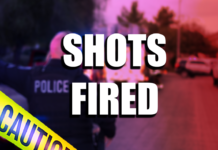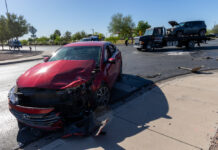
Seven-foot shelves stacked with white filing boxes fill the room.
The objects that clutter the floor around the shelves seem random — a Huggies Diapers box, a case of beer and a computer part. In one corner, two refrigerators and a freezer are stored with biological samples. In a small room nearby, a Liberty safe — large enough for a man to crouch inside — is packed with firearms.
Lisa Hendrix, property and evidence manager for the Maricopa Police Department, is charged with keeping track of the approximately 14,000 items mostly housed inside an evidence trailer at the agency’s current headquarters near Madison and Wilson avenues.
A long-time employee for Discover Card, Hendrix switched her career about seven years ago after seeing a job posting for an evidence technician at the Phoenix Police Department. It didn’t take long to realize she had found her niche.
“It just appealed to me,” she said. “It just became a passion for me.”
Hendrix eventually took a job at Maricopa’s young department about four years ago. As the department pushes into the future with a new headquarters off White and Parker Road set to open in September, the property and evidence manager plans to stick with her passion and make the move as well.
But it won’t be simple.
“It’s not going to be like, ‘everybody pitch in,’ like when you move yourself,” she said.
Moving thousands of items tied to the agency’s cases will be a process conducted with extreme care.
“We’ll be very hands on,” Hendrix said. “There’ll be a lot of eyes in the room and a lot of eyes on the other end when we get the items. If at any point in the process we discover something is not sealed, everything will come to a halt and we’re going to evaluate everything that’s in transit. … We’re going to look and make sure that that might just be an isolated case. There are checks and balances for that.”
Because the property involved is part of ongoing police investigations and judicial cases, Hendrix could not elaborate on the details of the move or when it will take place.
“In simple terms, we’re going to take the evidence boxes that we have, seal them, we’re going to initial the seals and then they’re going to be transported to the new building, where we’re going to verify the seals are still intact, and then we’re going to put them on the shelves over there,” she said.
Only department employees and members of a firm hired to conduct the move will be allowed to participate. In addition, Hendrix said a commander with the department has past experience making such moves.
Unlike the current property and evidence trailer, which has more floor space where large items are kept, the department’s new evidence facility features more vertical space, Hendrix said. Plus, the new digs will house state-of-the-art “electronic, rolling shelves” that move rows with the push of a button.
“It’s great,” she said. “I’m so excited we get those.”
The new place also will include a designated area for firearms storage, a special room for drugs and an area in a secured lot to store any large items such as bicycles and vehicles.
Of the 14,000 items Hendrix manages, nearly 6,000 are discs, which are uploaded with case-related material such as crime-scene photos and interviews with witnesses. Close to 500 items are blood kits from DUI cases. Around 300 items are firearms.
All items are entered into a database with an associated case number. Once an item is packaged, an evidence manager like Hendrix cannot open the packaging.
“We have a strict policy from Day One,” she said. “Sealed in. Sealed out.”
The life of the evidence — every time an investigator asks to the see the item — is tracked.
The amount of time the department holds on to evidence can vary, Hendrix explained. It could be one year; it could be 50 years. The case the evidence pertains to must be completely resolved in court.
“There can’t be any chances of appeals,” she said.
A county or city attorney will notify the department when evidence no longer is needed. At that point, the department will toss items that cannot be used, or sell usable items at an auction.
Because of the department’s small size, the agency lacks the staffing other departments have to gather evidence at a crime scene and impound the items.
Hendrix said during a homicide investigation last November when a 26-year-old man was shot multiple times at a grain company facility on Cowtown Road, it took around three to four hours for police officials to impound the materials.



![Alleged car thief released without charges Phoenix police stop a stolen vehicle on April 20, 2024. [Facebook]](https://www.inmaricopa.com/wp-content/uploads/2024/04/IMG_5040-218x150.jpg)











